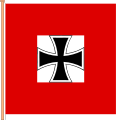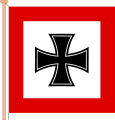- Oberkommando des Heeres
-
The Oberkommando des Heeres (OKH) was Nazi Germany's High Command of the Army from 1936 to 1945. The Oberkommando der Wehrmacht (Supreme High Command of the Armed Forces or OKW) commanded OKH only in theory. However, after 1941, the OKW de facto directly commanded operations on the Western front while the OKH commanded the Eastern front.
For commanding the navy and the air force, Third Reich had also the Oberkommando der Marine (OKM) and the Oberkommando der Luftwaffe (OKL) respectively. These were theoretically subordinate to the OKW, but in actuality acted quite independently.
Contents
Overview
The Oberbefehlshaber des Heeres (Commander of the Army') in the Wehrmacht was
- from 1935 to 1938, Generaloberst Werner von Fritsch;
- from 1938 to 19 December 1941, Generalfeldmarschall Walther von Brauchitsch
- from 19 December 1941 to 30 April 1945, Führer and Reichskanzler Adolf Hitler
- and from 30 April 1945 to 8 May 1945, Generalfeldmarschall Ferdinand Schörner
The OKH did not plan operations, following in German tradition. This task was left to the General Staff, so actually the most important man in the Army (and the Navy, but less so in the Luftwaffe, which was commanded by Hermann Göring) was the Chief of the General Staff (Chef des Generalstabs des Heeres). Das Heer (the Army) always has been the leading factor in planning campaigns. Thus there was no such thing as combined planning of the different services. The position of the Oberkommando der Wehrmacht (OKW)], which was by definition superior to the OKH, was not intended for that, nor did it have the resources to do so.
Later in the war, OKH became responsible for fewer and fewer tasks, with Adolf Hitler, assisted by OKW, taking an increasing role in the planning and running of operations. For example, the invasion of Norway was entirely planned outside OKH. During the April 1945 allied campaign towards Berlin, disputes between OKH and OKW over strategic priorities were commonplace. Since the Eastern Front was the responsibility of OKH, Field Marshal Wilhelm Keitel displayed callous disregard for German failures against the Soviets. General Heinz Guderian, then chief of OKH, resented Keitel for his lack of support in getting Hitler to send troops to counter Soviet advances east of the Oder river.
Although both OKW and OKH were headquartered in Zossen during the Third Reich, the functional and operational independence of both establishments were not lost on the respective staff during their tenure. Personnel at the sprawling Zossen compound remarked that even if Maybach 2 (the OKW complex) was completely destroyed, the OKH staff in Maybach 1 would scarcely notice. The camouflaged facilities were separated physically by a fence also maintained structurally different mindsets towards their objectives.
On 28 April 1945 (two days before his suicide), Hitler formally subordinated OKH to OKW, giving the latter command of forces on the Eastern Front.[1]
Flag for the Commander-In-Chief of the German Army
The design of this command flag was very simple. It only displayed the basic German nationalist colors of red, white and a black Iron Cross. For display on a motor vehicle the 30 cm (12 in) square flag was encased in a metal frame and held in place by a double-sided, clear perspex cover. As the Commander-In-Chief of the German Army inevitably held the rank of a generalfeldmarschall, the vehicle flag for this rank usually was displayed in conjunction with the command flag on the same vehicle.
Flag for the Chief of the German Army General Staff
This special flag was introduced only on 1 September 1944. At this time the office was held by Generaloberst Heinz Guderian. Because of some violent disputes with Hitler he was sent on leave on 28 March 1945, only 38 days before the end of the war. So it came that this flag was closely associated with Guderian. The flag was similar in certain aspects to the flag used by the Commander-In-Chief of the German Army. The differences were that four golden eagles had been added to the corners of the flag. Moreover a white swastika was placed on the Iron Cross in the center of the flag.
See also
- German general staff
- Glossary of WWII German military terms
References
- ^ Grier, Howard D. Hitler, Dönitz, and the Baltic Sea, Naval Institute Press, 2007, ISBN 1-59114-345-4. p. 121
Categories:- German High Command during World War II
- Heer (1935–1945)
Wikimedia Foundation. 2010.



